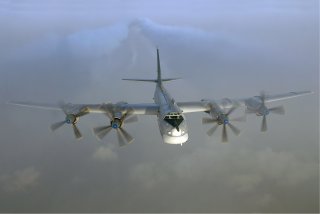Russia's Upgraded Tu-95MSM Bomber to Perform Test Flight This Month
It is likely that soon American fighters will be launching sorties to “escort” the upgraded Tu-95MSM as well.
Much like the American B-52, the Russian Tu-95 “Bear” bomber has been flying longer than any of its crews have likely been alive. The four-engine Russian strategic bomber and maritime patrol plane has remained in service because few other aircraft can cover such great distances and carry such a hefty payload.
Also, like the U.S. Air Force’s B-52, the Tu-95 has been steadily upgraded in recent years, and the latest version of the Cold War airframe will take to the skies in tests later this month.
Russian state media reported this week that the Tupolev Tu-95MSM heavily upgraded strategic missile-carrying bomber will perform its first test flight by the end of this month, even if some in Russia didn’t express the utmost confidence.
“I hope our Tu-95 long-awaited heavily-upgraded plane will take to the skies in Taganrog before the end of August,” United Aircraft Corporation (UAC) Head Yuri Slyusar reported to Russian president Vladimir Putin, as reported by Tass.
Oldie But a Goodie
The Tu-95 “Bear” is one of the oldest designs in active service in the Russian Air Force. It is driven by eight contra-rotating turboprop engines and it remains the only propeller-powered bomber in service today.
Despite its age, it shows no signs of leaving service anytime soon. With the Russian Air Force rolling out the Tu-95MSM modernization the aircraft has received significant new capabilities that go far beyond its original role of dropping unguided bombs. The upgraded Tu-95MS is equipped with the Kh-55 air-launched cruise missile, a subsonic missile that has a range of approximately 2500 kilometers.
The Tu-95MSM modernization effort provides the aircraft with the ability to fire the Kh-101 and Kh-102 cruise missiles, which are primarily carried by the newer Tu-160 bomber. Because of the increased length of those missiles, the Kh-101 and Kh-102 cannot be carried on the internal rotary launcher of the Tu-95MS. As a result, the Tu-95MSM required the installation of four additional external pylons, which can carry two missiles each. Two of the pylons are placed to either side between the fuselage and the innermost engine, while the other two are placed between on either side between the innermost and outermost engines.
Other improvements to the Tu-95MSM include frame upgrades, strengthening of the wings to allow the new missiles to be carried safely, while the engines and propellers have also been upgraded—the latter allowed increased flight performance. In addition, new radar and data display systems have been installed.
As previously reported, the Tu-95MSM could represent a slow downsizing of the Russian strategic bomber fleet and these upgrades will not be applied to the entire Tu-95MS fleet.
Logging the Miles
As noted, the Bear has remained in use because of its range and payload capability, but also for its use as maritime patrol aircraft. In the latter capacity a few of the Tu-95 pilots have been logging some serious miles as the warbirds have made almost routine flights over the neutral waters of the Chukchi, Bering and Okhotsk Seas and the northern part of the Pacific Ocean in recent months.
Despite the age of the aircraft, the Tu-95MS can still fly great distances and have been making what almost seems to be regularly scheduled flights near American waters. It is likely that soon American fighters will be launching sorties to “escort” the upgraded Tu-95MSM as well.
Peter Suciu is a Michigan-based writer who has contributed to more than four dozen magazines, newspapers and websites. He is the author of several books on military headgear including A Gallery of Military Headdress, which is available on Amazon.com.
Image: Wikimedia Commons / Sergey Krivchikov–Russian AviaPhoto Team

